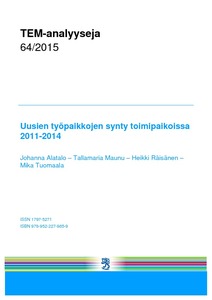Uusien työpaikkojen synty toimipaikoissa 2011-2014
Alatalo, Johanna; Maunu, Tallamaria; Räisänen, Heikki; Tuomaala, Mika (2015-04-15)
Alatalo, Johanna
Maunu, Tallamaria
Räisänen, Heikki
Tuomaala, Mika
työ- ja elinkeinoministeriö
15.04.2015
Julkaisusarja:
TEM-analyyseja 64/2015This publication is copyrighted. You may download, display and print it for Your own personal use. Commercial use is prohibited.
Julkaisun pysyvä osoite on
http://urn.fi/URN:ISBN:978-952-227-985-9Tiivistelmä
Analyysissa käsitellään vuosina 2011–2014 tapahtunutta uusien työpaikkojen syntyä toimipaikkatasolla. Tarkastelussa on aluksi 1) yleiskuva toimialoittaisesta työllisyyden nettomuutoksesta, sitten 2) käsitellään toimipaikkojen uusien työpaikkojen synnyn bruttosuureita ja odotuksia työvoiman määrän muutoksille sekä 3) replikoidaan TEM-analyysin 51/2013 (Minne ja miten uudet työpaikat syntyvät?) uusien työpaikkojen syntyyn liittyvät mallinnukset myös vuosille 2012, 2013 ja 2014. Lisäksi laaditaan uusia mallinnuksia.
